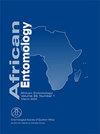Three New Biological Control Programmes for South Africa: Brazilian Pepper, Tamarix and Tradescantia
IF 1.2
4区 农林科学
Q3 ENTOMOLOGY
引用次数: 5
Abstract
Three weed biological control (biocontrol) programmes are described, all of which are considered to be ‘transfer projects’ that were initiated elsewhere, and on which South Africa has piggybacked its biocontrol efforts. Using knowledge and expertise from international collaborators, South African weed researchers are following a long tradition of transfer projects, which has been a largely successful and practical approach to biocontrol. Two Brazilian weeds, the Brazilian pepper tree Schinus terebinthifolia and the spiderwort Tradescantia fluminensis are being targeted, along with the Old-World trees Tamarix ramosissima and T. chinensis. The potential biocontrol agents are described and ranked for the two trees according to what has been discovered elsewhere, while the agent already released against T. fluminensis is rated (as poor), and other potential agents are considered. The addition of molecular techniques, climate matching and remote sensing in transfer projects can increase the chance of successful biocontrol and the inclusion of these techniques in the three new programmes is discussed. Transfer projects are a cost-effective and pragmatic way to pick winning biocontrol programmes.南非三个新的生物防治项目:巴西辣椒、柽柳和柽柳
描述了三个杂草生物控制(生物控制)方案,所有这些方案都被认为是在其他地方启动的“转移项目”,南非在这些项目的基础上开展了生物控制工作。南非杂草研究人员利用国际合作者的知识和专业知识,遵循着长期的转移项目传统,这在很大程度上是一种成功和实用的生物控制方法。两种巴西杂草,巴西胡椒树Schinus terebinthifolia和蜘蛛草Tradescantia fluminensis,以及旧大陆的Tamarix ramosissima和T.chinensis,都成为攻击目标。根据在其他地方发现的情况,对这两棵树的潜在生物防治剂进行了描述和排名,而已经释放的针对弗氏T.fluminensis的制剂被评为(较差),并考虑了其他潜在制剂。在转移项目中增加分子技术、气候匹配和遥感可以增加生物控制成功的机会,并讨论了将这些技术纳入三个新方案的问题。转移项目是选择成功的生物控制方案的一种具有成本效益和实用性的方式。
本文章由计算机程序翻译,如有差异,请以英文原文为准。
求助全文
约1分钟内获得全文
求助全文
来源期刊

African Entomology
生物-昆虫学
CiteScore
2.00
自引率
0.00%
发文量
17
审稿时长
6-12 weeks
期刊介绍:
African Entomology (ISSN 1021-3589 – print / 2224-8854 – online) replaced the old Journal of the Entomological Society of Southern Africa in 1993. A single volume consisting of two issues (March and September) is published annually. The journal is indexed in all major abstracting journals
African Entomology is a peer reviewed scientific journal that publishes original research articles and short communications on all aspects of entomology, with an emphasis on the advancement of entomology on the African continent.
 求助内容:
求助内容: 应助结果提醒方式:
应助结果提醒方式:


